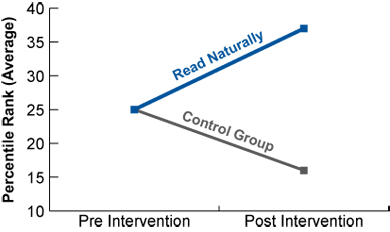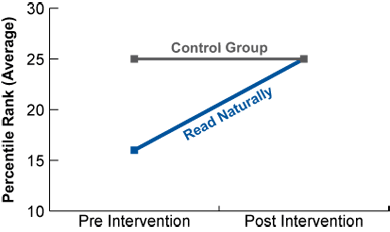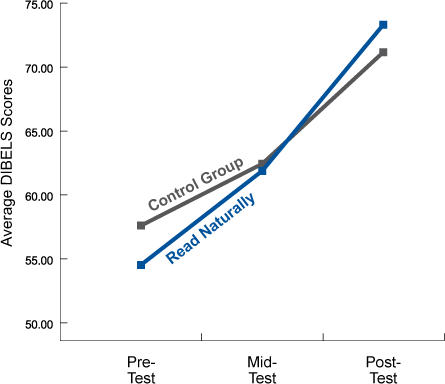Evidence-Based Studies
Treatment Group/Randomized Control Group
Empirical evaluation of Read Naturally effects: A randomized control trial
Christ, T. J., & Davie, J. (2009)
University of Minnesota, Minneapolis, MN
A study by researchers at the University of Minnesota found that students using Read Naturally Software Edition had 39 percent greater gains in fluency than students in a control group. The study was led by Theodore Christ, Ph.D., an associate professor in the University’s Department of Educational Psychology.
The study was a randomized control trial that was conducted in late 2008 and early 2009 across six schools with 109 low-performing students in third grade. Those students assigned to the Read Naturally group received intervention instruction for 30 minutes per day, five days a week, for 10 weeks. Students in the control group received normal classroom reading instruction with no supplemental fluency instruction.
Multiple standardized measures of reading accuracy and fluency indicated that students in the Read Naturally group outperformed students in the control group on all measures of accuracy and fluency.
The National Center on Intensive Intervention (NCII) has posted a review of the Christ study, which shows that Read Naturally has statistically significant and academically meaningful effects on both reading fluency and accuracy. The review can be found on the NCII website.
Study Results
The adjusted posttests of Read Naturally students in the Christ study showed statistically significant, moderate to large effect sizes in fluency and accuracy. The Gort 4 Accuracy measure and the Gort 4 Fluency measure both had effect sizes of .67, which correspond to moderate to large effects. View results
Accuracy Results
Both the intervention group using Read Naturally and the control group started at about the 25th percentile in accuracy. The control group did not maintain reading accuracy and declined to about the 16th percentile. In contrast, a random selection of students from the same class who received instruction with Read Naturally Software Edition had statistically significant improvement from the 25th to the 37th percentile on national norms after only 10 weeks of intervention. The following graph depicts those results for accuracy:
Reading Accuracy (GORT)

Fluency Results
The intervention group using Read Naturally Software Edition started at the 16th percentile and improved to the 25th percentile on national norms. In comparison, the control group started at the 25th percentile and did not improve. The following graph depicts those fluency results in percentile ranks:
Reading Fluency (GORT)

DIBELS Results
The study examined the students’ fluency gains using results from Dynamic Indicators of Basic Early Literacy Skills (DIBELS) assessments. The Read Naturally students gained, on average, 1.53 WCPM/min per week compared to 1.10 WCPM/min per week for students in the control group—39% greater gains for students in the Read Naturally group.
The following graph illustrates that the DIBELS average for the Read Naturally group was below that of the control group at pre-test, and after 10 weeks of intervention, the Read Naturally students outperformed those in the control group.
Comparison of Average DIBELS Scores Over the Course of the Study

Students in the Read Naturally group gained, on average, .40 WCPM/min per week more than students in the control group. The magnitude of improvement should be compared to typical growth and expected levels of achievement among third-grade students. Published estimates of typical growth in third grade approximate 1.2 WCPM/min among students in general education and .58 WCMP/min among students in special education. Students are expected to exceed 100 WCPM/min by the end of the third grade if they are to be successful on large scale state-wide assessments. A sustained additional improvement of .40 WCPM/min per week across the academic year is substantial. Assuming a typical growth rate of approximately 1.20 WCPM/min per week, a 39% improvement would result in improved growth to 1.68 WCPM/min per week, which is a cumulative gain of 14.4 more words read correct across 36 weeks.
These results were not specific to DIBELS measures. After accounting for pre-test levels of performance, the students in the Read Naturally group scored one to two standard score units better on most standardized measures of fluency and accuracy after 10 weeks of intervention. If extrapolated across the school year, those gains would translate to approximately three to seven standard score units of improved performance for those students within the Read Naturally group compared to the control group. Such improvements would be substantial.
Other Factors
The observed gains for the experimental group were obtained with minimal resources. Teacher and personnel time is one of the most valuable resources in schools. The Read Naturally intervention was implemented with minimal support. Teachers received the recommended training in the Read Naturally strategy and completed the SE Self-Study course to support them in the software implementation. Individual teachers were able to supervise their groups of students while the students received individualized instruction from Read Naturally SE.
For More Information
Evidence-Based Studies
Overview of Evidence-Based Studies
Strong Evidence for the Read Naturally Strategy
- Christ, T. J., & Davie, J. (2009): Empirical evaluation of Read Naturally effects: A randomized control trial
- Arvans, R. (2010): Improving reading fluency and comprehension in elementary students using Read Naturally
Moderate Evidence for the Read Naturally Strategy
- Tucker, C. & Jones, D. (2010): Response to intervention: Increasing fluency, rate, and accuracy for students at risk for reading failure
- Heistad, D. (2005): The effects of Read Naturally on fluency and reading comprehension: A supplemental service intervention (four-school study)
- Heistad, D. (2008): The effects of Read Naturally on grade 3 reading: A study in the Minneapolis Public Schools
- Graves, A. W., Duesbery, L., Pyle, N. B., Brandon, R. R., & McIntosh, A. S. (2011): Two studies of Tier II literacy development: Throwing sixth graders a lifeline
Promising Evidence for the Read Naturally Strategy
Please let us know what questions you have so we can assist. For Technical Support, please call us or submit a software support request.
